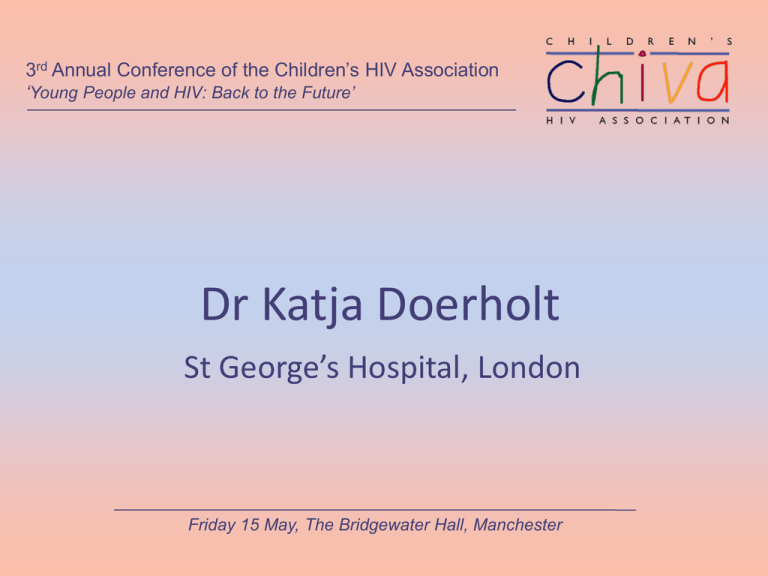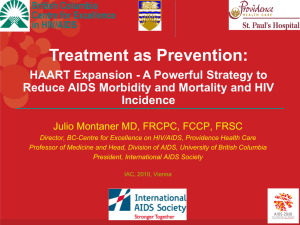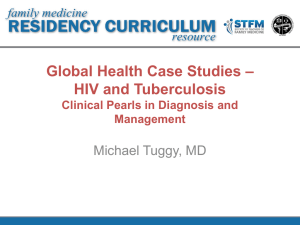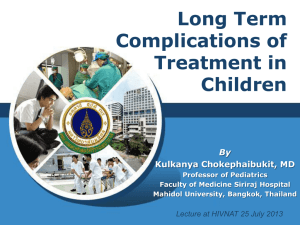
3rd Annual Conference of the Children’s HIV Association
‘Young People and HIV: Back to the Future’
Dr Katja Doerholt
St George’s Hospital, London
Friday 15 May, The Bridgewater Hall, Manchester
Update on cardiovascular, bone and
renal toxicity
Changing views
Katja Doerholt
Outline of Presentation
Update on side effects of antiretroviral therapy
(ART):
• Lipids, lipodystrophy syndrome and coronary
heart disease (CHD)
• Kidney
• Bone
• Summary
Problem - Cause
How much is………
Effect of
drug
Effect of
HIV
Toxicity
Host
genetics
Metabolic changes and Coronary heart
disease (CHD)
Drugs
Environmental
factors
Smoking, weight,
exercise…….
HIV
HDL ↓, LDL↓,
TG↑
Individual Host
Genetics
Hyperlipidaemia
HIV – ART - Coronary heart
disease (CHD)
• HAART has been associated with
– Metabolic abnormalities
Concerns about the potential of HAART to
significantly increase the risk of CHD despite
conflicting evidence
?drug holiday possibly good idea
Then came the SMART results
HIV - ART - CHD
BUT Smart
• Treatment interruption (TI) with more time on
lower cd4 cell count were at a significantly
elevated risk of serious complications (2.1 vs.
1.4%, p = 0.04)
incl. heart attack, stroke and kidney or liver
disease
• ?increased level of inflammation responsible?
Further publications
HOPS and 2 large cohorts (WHIS & MACS)
reported
• cardiovascular risk group and baseline CD4
count < 350 cells/mm3 were independently
associated with cardiovascular disease
D.A.D
• MI appears mainly PI driven, since 2001
reduced, NNRTI not associated with increased
risk of MI
Data in children/YP
Miller et al. Case control study, Miami
• 42 HIV positive children and age and sex matched
control
• HIV positive children had higher TG, total and LDL
cholesterol levels, lower HDL
• Study authors concluded,
– "Children infected with HIV have adverse cardiac risk
profiles compared with NHANES controls
– Antiretroviral therapy has a significant influence on
these factors.”? Do we know this? What about HIV?
Further paediatric studies
• Morphologic and metabolic abnormalities in
vertically HIV-infected children and youth, LA
– height, weight, total and limb fat were lower than in controls
– high prevalence of lipid abnormalities among those on Pis
and evidence of developing insulin resistance
• These factors could accelerate lifetime risk for
cardiovascular disease
BUT PI group had lower CD4 baseline ? Toxicity ? HIV??
Increased inflammation
Further paediatric studies
• Immunological recovery and metabolic disorders in
severe immunodeficiency HIV type 1-infected
children on HAART, Spain
– ?unclear selection of kids, biased
• Low prevalence of insulin resistance among HIVinfected children receiving NNRTI-based HAART in
Thailand
– Insulin resistance is uncommon among children receiving
NNRTI-based HAART and is unrelated to lipodystrophy
– NRTIs and PIs are more associated with insulin resistance
then NNRTIs
Further paediatric studies
• Lipid and glucose alterations
in HIV-infected children beginning or changing ART
• Initiation or change in ART associated with significant
increases in lipid measures and insulin resistance
• Favorable lipid changes associated with CD4%
• Regimens with NNRTI and PI are associated with worse lipid
profiles than regimens that contain only 1
• Lipodystrophy and metabolic changes in HIVinfected children on NNRTI-based ART, Thailand
• More than half developed LD at 144 weeks after HAART
• Dyslipidaemia occurred in 11-12% of children
Further paediatric studies
• Active surveillance of body fat changes and
metabolic abnormalities in HIV-infected children
and adolescents in Europe: first round results
– 56% overall prevalence of lipodystrophy syndrome
– 3x more severe fat loss than severe fat gain
– 31% had dyslipidaemia
– 29% had both dyslipidaemia and body fat alterations
• One of the few paediatric studies with large number of
children/YP
Biomarkers
• Biomarkers of Vascular Dysfunction in HIVinfected Children with and without
Hyperlipidemia
– HIV+ children with and without Hyperlipidaemia
show greater levels of biomarkers than controls
– These changes may reflect vascular dysfunction
and may be associated with elevated
cardiovascular risk over the long-term.
– Differences are pronounced in coagulant and
endothelial dysfunction.
The ABC story
D.A.D.: Abacavir (ABC) and MI
• D.A.D. (Data Collection on Adverse Events of
Anti-HIV Drugs) cohort
– Almost doubles the risk of MI if recent ABC
– But overall risk low without ABC 1.6% over 5yrs
– High risk patients much increased risk compared
to other groups of Framingham definition
Smart: ABC and MI
• MI: about a 4-fold risk for those on ABC
• hsCRP levels were 27% higher and IL-6 levels
were 16% higher in those on ABC (both p = 0.02).
• ddI no increased risk of CVD
• SMART authors "This adverse effect appears to be
only clinically relevant to consider among
patients with elevated underlying cardiovascular
risk.”
• ABC might cause cardiovascular problems,
perhaps through drug-induced inflammation.
ACTG A5001/ALLRT : ABC and
MI
• No Association of Abacavir (ABC) use with Risk
of Myocardial Infarction (MI) or Severe
Cardiovascular Disease Events (SCVD)
• Older age was significantly associated with
increased risk of MI. Older age, a history of
hypertension (HTN), and a family history of
CVD significantly associated with increased
risk of SCVD events"
Metabolic changes and Coronary heart
disease (CHD)
Drugs
Environmetal
factors
Smoking, weight,
exercise…….
HIV
HDL ↓, LDL↓,
TG↑,
inflammatory
markers
Individual Host
Genetics
Hyperlipidaemia
Renal toxicity
Tenofovir TDF
• TDF in adults well tolerated but patients with
pre existing renal problems more likely to have
side effects
• Renal toxicity from proximal renal tubular
dysfunction, renal failure and nephrogenic
diabetes insipidus
• Few data in kids
Adult data
• Long-term follow-up data of 1111 adults from 2 Gilead
RCTs 903 and 934
– Small differences in glomerular filtration rate over time
were noted but no clinically relevant renal disease by 144
weeks
• Duke
– 35 of 744 patients taking tenofovir developed
nephrotoxicity (7.5%).
– Significant independent predictors of nephrotoxicity in
future
– PI use, chronic pain (NSAID), hypertension
– If TDF as part of NNRTI low risk for nephrotoxicity
TDF CHIPS
Cohort & case controle study
• Cohort data TDF generally well tolerated
• 12 children (7.5 %) stopped TDF due to side
effects incl. 5 renal events
• hypophosphataemia in the 10 cases on TDF
occurred at median 18 months (IQR 17 to 20)
post-TDF start
• Clinic follow up often do not collect renal
tubular data
• Overall incidence was about 3% with biggest
risk factor current TDF
Bone
drugs
HIV
osteopenia
osteoporosis
Host
genetics &
environment
BMD
Adult data
• First-line PI-containing Regimens Enhance Decreased
Bone Mineral Density Greater than NNRTI-containing
Regimen in HIV-1-infected Patients: A Substudy of the
HIPPOCAMPE–ANRS 121 TrialC
– Before starting ARV, osteopenia was present in 31% of
patients
– Decrease in lumbar spine BMD worse in PI regimens
• Prospective Evaluation of Bone Mineral Density among
Middle-aged HIV-infected and -uninfected Women
– Highlights role of traditional risk factors for loss of bone
mineral density, age, smoking, depression, opoids
Adult data
• Risk Factors for Reduced Bone Mineral Density
in HIV-infected Individuals in the Modern
HAART
– Age, BMI, ethnicity and low CD4 count
Adult data
• First-line PI-containing Regimens Enhance Decreased
Bone Mineral Density Greater than NNRTI-containing
Regimen in HIV-1-infected Patients: A Substudy of the
HIPPOCAMPE–ANRS 121 TrialC
– Before starting ARV, osteopenia was present in 31% of
patients
– Decrease in lumbar spine BMD worse in PI regimens
• Prospective Evaluation of Bone Mineral Density among
Middle-aged HIV-infected and -uninfected Women
– Highlights role of traditional risk factors for loss of bone
mineral density, age, smoking, depression, opoids
Paediatric studies
• Long-term Effect of HAART Containing
Tenofovir on Bone Mass in HIV-infected
Children and Adolescents: A 48-Month
Longitudinal Assessment
– No BM deterioration in HAART regimens with TDF
Conclusions
• Studies support the recent shift toward earlier
treatment before significant immune dysfunction
develops
– benefits of maintaining a high CD4 cell count may be beyond
avoidance of AIDS-related OI
• Contradictions probably due to
– different study designs and populations
– observational methods with limitations in controlling
confounding
– limited follow-up periods
– the absence of HIV negative control subjects
– Most paediatric studies had only small number of children
Conclusions
• Need for long term follow up of CHIPS /
AALPHI and large European collaborations
• Still awaiting case definition for lipodystrophy
syndrome
• Should we look for other inflammatory marker
as predictor
• Watch the space re cardiovascular disease







